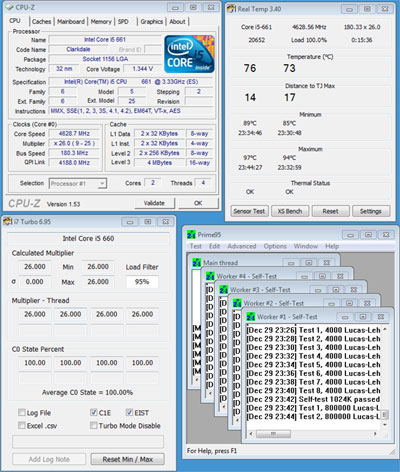|
|
|
|
|
Intel Clarkdale |
|
Join the community - in the OCAU Forums!
|
Overclocking, Conclusions and Recommendations
OVERCLOCKING
Overclocking the 661 was a snap. Due to the 32nm manufacturing process, temperature and wattage are lower than for 45nm CPU. This always means that you have more frequency headroom. Furthermore the 661’s high multiplier of 25x is an advantage. For overclocking I exchanged the flimsy retail heat sink with a “Mugen 2” and added a full-size 12cm fan. With a core voltage of 1.35V and the memory controller at a moderate 1.2V, I raised the 661 from 3.33 GHz to 4.63 GHz.

I did not press the CPU further on, but I guess with water cooling this 661 sample would run stable up to 4800 MHz. My result seems to be no exception, because several enthusiast sites have are already posted screen shots showing i5 600 engineering samples running well above 5 GHz and even close to 6 GHz with phase-change or dry ice cooling. I would not be surprised if Clarkdale becomes the overclocker’s choice in the near future.
CONCLUSIONS AND RECOMMENDATIONS
Intel’s new integrated graphics solution is a major improvement compared with G45. Hardware acceleration is working and high definition video playback is smooth. Most 3D games are playable up to 1280x1024 with entry level settings – but not at higher resolutions or high detail. The GMA HD is good enough for entry level 3D gaming, but not for the advertised “mainstream 3D gaming”. However if you run the 661 with a separate graphics card, it will play most 3D games faster than a quad-core 750 due to its much higher frequency and the fact that most games still don’t take full advantage of 4 cores.
The 661 is running applications around 30% faster than its venerable predecessor, the E8600. This is by all means a major improvement. In single-threaded or not very multi-threaded applications the 661 is often performing even better than a quadcore 750 due to its higher clock speed. In heavy multi-threaded applications the 661 can of course not compete with a quadcore 750. But we found that even then the 661 is not much slower than a previous generation quadcore CPU like the Q9650 or the Phenom II X4 965.
Thanks to 32nm manufacturing “Clarkdale” runs clock-for-clock cooler and more energy efficient than its 45nm siblings. For the same reason Clarkdale offers excellent overclocking potential. We guess that 1 GHz to 1.2 GHz on-top frequency are a given with air-cooling. A bit disappointing is the fact that Turbo Mode is adding only 2 speed bins, while an i5 700 series is boosted by up to 4 speed bins. It does not matter though, because what you don’t get with TM, you can simply add yourself by manually setting the CPU frequency higher in the BIOS. Also keep in mind that the i3 500 Clarkdale series does not sport TM at all.
Do I wish for anything? Yes I do: A Clarkdale processor without integrated graphics. Intel is great at differentiating products for each and every market niche. So why don’t we get a Clarkdale i5 or i3 without GMA HD? Such a stripped down Clarkdale core would cost less to manufacture and run even a bit cooler and more energy efficient than with integrated graphics. Intel is predicting massive growth of small form factor solutions with integrated graphics for desktops and mobile in the future. And given AMD’s (ATI’s) competence and competition in this field, we understand that having a well performing platform with integrated graphics is commercially important. But there will be certainly still a market for a dual core processor without a graphic core. It seems though that in the future you would have to take an Intel quadcore processor, if you want to run a CPU without integrated graphics.
The i5 600 series comes at a price. Australian vendors have the 661 listed at around AU $270 and the slightly slower 650 (processor @3.2 GHz, graphic core @733 MHz) at AU $250. You can have a quad-core 750 (2.66 GHz) for around AU $240. The quadcore i5 700 series does not feature Hyperthreading. The dual i5 600 series does have it. A processor of either series runs therefore 4 threads. But there is still a difference between 4 and 2 physical cores. While HT helps to increase performance of multithreaded running applications, it can’t replace 2 additional physical cores. If you don’t have use for integrated graphics, I guess the choice for somebody with a budget of around AU $250 would be rather the 750 than the 650/661.
Here is the better deal: Forget the “occasional” 2 speed bins you get with the i5 600 Turbo Mode. You can easily add “permanently” 2 speed bins and actually much more than this by manually setting the CPU frequency higher in the BIOS. If you can live without TM, the i3 looks value-for-money more attractive than the i5, at least at current prices. You can have an i3 530 clocked at 2.92 GHz for around AU $160. And looking at our Clarkdale overclocking experience, I guess there won’t be much of a problem to run an i3 530 at least at 4 GHz. This gives you a cool running, energy efficient, top performing CPU capable of running 4 threads simultaneously for a very reasonable price. And integrated graphics come as the icing on the cake.
|
|
Advertisement:
All original content copyright James Rolfe.
All rights reserved. No reproduction allowed without written permission.
Interested in advertising on OCAU? Contact us for info.
|

|


